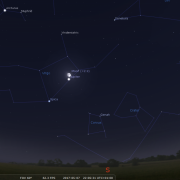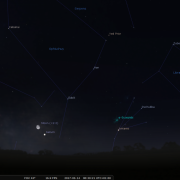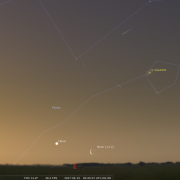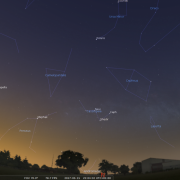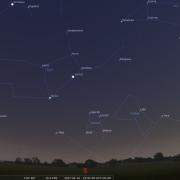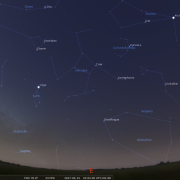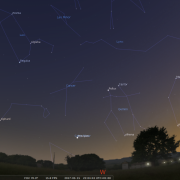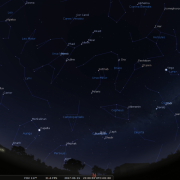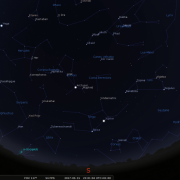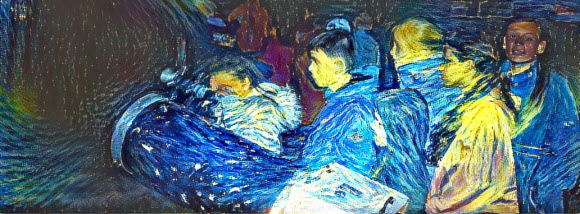
Welcome to the WDAS monthly newsletter for May 2017: a digest of the month's latest contributions to our website. Below you'll find Society News, Sky Notes and In-Focus articles printed in full. There's also future events, and trailers for other articles which appear in full on the website - just a click away!
On the website you'll also be able to comment on articles, and if you'd like to play an editorial role in creating new content, just let us know!
Society News
Our Solar System has some pockmarked, weird and contorted moons. Let's have a lok at a few of them.
First up: Miranda, Uranus’s largest moon.
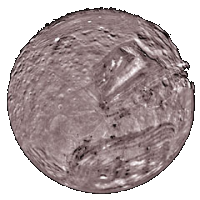 Miranda has some very distinct features that have left astronomers wondering why it’s so ugly. As well as the usual craters and pockmarks that cover any rocky object with basically no atmosphere, Miranda has deep, almost parallel gashes running along its southern hemisphere. It looks a bit like a ball of yarn. These deep grooves are confined to three regions in the Southern hemisphere.
Miranda has some very distinct features that have left astronomers wondering why it’s so ugly. As well as the usual craters and pockmarks that cover any rocky object with basically no atmosphere, Miranda has deep, almost parallel gashes running along its southern hemisphere. It looks a bit like a ball of yarn. These deep grooves are confined to three regions in the Southern hemisphere.
Astronomers have a couple of ideas about where these features come from.
- One possibility is that Miranda was hit by something so large that it actually broke the moon apart, and the patterns formed as the pieces clumped back together. (Don’t you love if astronomers aren’t sure how a thing formed, they’ll often suggest that it got hit by something else?)
- More recently, researchers have suggested that the ridges and grooves are actually Uranus’s fault. As Uranus and Miranda orbit, they pull on each other, deforming each other a little bit. And that deformation would generate some heat inside Miranda — maybe enough cause to geological activity, like icy volcanoes or stretching, which could have formed those ridges.
There are still some unresolved questions, though. Like, why these ridges are only found these spots. We might have to wait until the next mission to Uranus to find out.
Next, let’s look at Iapetus, one of Saturn’s dozens of moons.
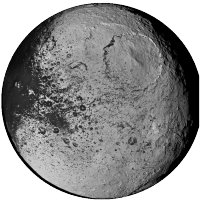 Iapetus looks like the death star from Star Wars, after it’s been splatted by the mother of all seagulls. Half of it is covered with some unknown, dark substance. It also has a big ridge running along the equator, which was discovered by the Cassini orbiter in 2005.
Iapetus looks like the death star from Star Wars, after it’s been splatted by the mother of all seagulls. Half of it is covered with some unknown, dark substance. It also has a big ridge running along the equator, which was discovered by the Cassini orbiter in 2005.
Scientists have come to a kind of consensus about the dark material: they believe it’s caused by two factors.
- First, Iapetus sits right inside the Saturn’s “Phoebe” ring: an enormous, diffuse ring discovered surrounding Saturn in 2009. Dark material from the Phoebe ring falls into Iapetus, mostly on the leading side.
- Second, ice sublimating, or vaporizing, off of Iapetus’s surface leaves behind a residue of darker particles that were suspended in it. The part of the moon that’s already a little darker because of the material from the Phoebe ring is also a little warmer, so more ice sublimates on that side.
The equatorial ridge is still a mystery, though! One option is that Iapetus used to have rings — or “moon moons”, if you will — but the ring material fell into Iapetus, creating a ridge along what was once the ring’s orbital path. It’s also possible that Iapetus just used to be very squat, and the bulge is all that remains from that period of its life.
Lastly, let’s look at Hyperion - another of Saturn’s odd moons.
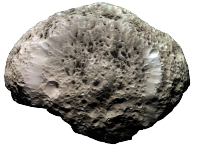 It looks a lot like a sponge. It’s about as big as something can be before its gravity forces it into a more spherical shape. It’s strange texture is probably because Hyperion is mostly ice, and not very dense. So when it’s hit by meteorites, they just punch down through the ice like a very aggressive knife through butter, giving it that spongy look.
It looks a lot like a sponge. It’s about as big as something can be before its gravity forces it into a more spherical shape. It’s strange texture is probably because Hyperion is mostly ice, and not very dense. So when it’s hit by meteorites, they just punch down through the ice like a very aggressive knife through butter, giving it that spongy look.
But even though it’s mostly ice, Hyperion is a lot less reflective than we’d expect it to be. So there’s a layer of some substance on there, but astronomers don’t know exactly what it is. It resembles the material on Iapetus’s dark side, and as Hyperion is very icy, sublimation might also play a role on Hyperion.
But Hyperion doesn’t just look bizarre, it also behaves strangely. Its rotation is ‘super chaotic’, meaning that it’s very hard to predict which way Hyperion will be facing at any given time. That probably comes from the way Hyperion’s lopsided orbit lines up with the orbit of Saturn’s largest moon, Titan, which leads to a gravitational pull from Titan that keeps Hyperion’s orbit lopsided, and its rotation from stabilizing.
So, ugly or not? Beauty is in the eye of the beholder, they say. But studying them has also helps us learn the history of our solar system.
The video and most of the material for this article was put together by YouTube channel "SciShow Space". You can support their work creating videos that help to teach the world about astronomy by sponsoring a dollar or two per month via their Patreon page.
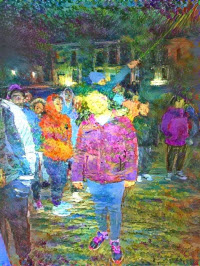 For the second year in succession our Star party event planned for visiting pupils of Ayresome Primary school in Middlesbrough, went ahead under crystal clear skies. (Shock horror, yes, it is hard to believe) Requested by Libby Lavelle, Assistant Head Teacher, after last year’s successful evening which delighted and enthused the pupils, this year’s two dozen strong party of 10 and 11 year olds were already excited by the prospect of something similar.
For the second year in succession our Star party event planned for visiting pupils of Ayresome Primary school in Middlesbrough, went ahead under crystal clear skies. (Shock horror, yes, it is hard to believe) Requested by Libby Lavelle, Assistant Head Teacher, after last year’s successful evening which delighted and enthused the pupils, this year’s two dozen strong party of 10 and 11 year olds were already excited by the prospect of something similar.
With the party staying at Whitby Youth Hostel, the event was again held on the grassed outer approach courtyard area adjacent to the drive way along to the hostel. Mark, Keith and Lee were joined by Andy L this year, so 4 scopes were in operation.
Before observing commenced, Mark and Andy demonstrated the scale solar system along the drive. Planned use of the new inflatable planets sourced by Andi Ye had to be shelved due to the nagging breeze, visions of Saturn disappearing over the Abbey came to mind. Apart from the odd passing car interrupting proceedings, the bouncy ball and glow stones approach proved more than satisfactory in purveying the enormity of it all.
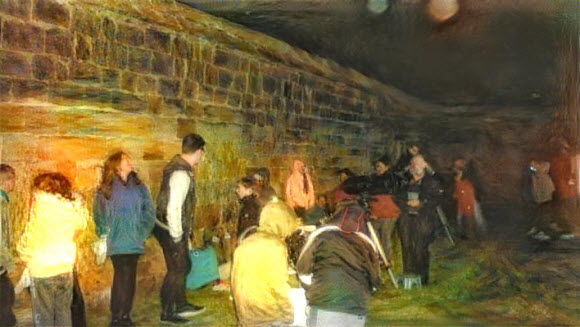
Sheltered somewhat by the proximity of the perimeter wall, the location was ideal for viewing Jupiter, visible across in the SE. The planets ‘belts’ and Galilean moons, enthralling all who peered through the eyepiece. Mark conducted a laser point tour of the spring sky, pointing out the brighter stars and constellations, which we learned from the pupils, are mostly obscured from Middlesbrough due to light pollution, so for many it was their first meaningful inspection of the night sky.
Moonrise (just a couple of days beyond full) certainly caused a stir, although the bright moonlight did scupper attempts to show a few deep sky objects. We also had to move ‘camp’ a little in order to show the moon through the scopes. The reaction was a mixture of stunned astonishment and excited jubilation (and that was just Andy!).
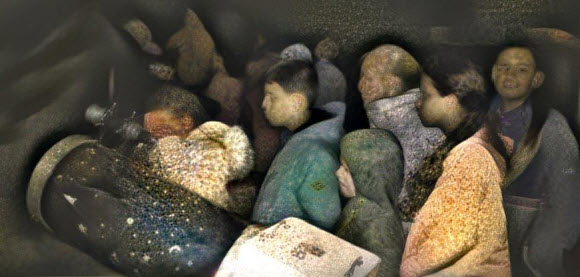
By 22:30h, long passed the expected time for supper, proceedings finally came to an halt. A most rewarding night for all and one that, weather permitting, will be repeated next year.
The ‘summer ‘ star party season is almost upon us and as per other years we shall be hosting events from the Cpt Cook headland area on West Cliff; and some from the Archery green area later in the summer.
The dates listed below are for May and June scheduled events, (weather permitting). If the proceeding evening looks a better bet when we get to these dates, that may then become the observing night. If you can join us, (especially if you can bring a telescope along) it would be most appreciated. Over the years we’ve experienced some absolutely stunning evening events (and the occasional dud). But if the weathers fine, there are objects to view and the public is about, they are always evenings to remember. Hope to see you!
All of the following from West Cliff, Captiain Cook Headland:
- 06-May-2017 from 21:00h: observations of waxing Moon and Jupiter
- 27-May-2017 from 21:00h: Spring Bank weekend Solar and Jupiter observations
- 23-Jun-2017 from 21:00h: Lunar and Planetary observations
- 09-Jun-2017 from 21:00h: Lunar and Planetary observations
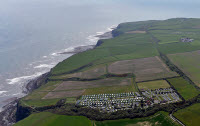 This event has now been postponed a few weeks whilst the Holiday campsite undergoes new staff training, apparently apart from other issues they have been incredibly short staffed. The delay will be used to further promote a future event: the management would like to do this properly and would also like to be on hand. No definite dates yet, but we may be looking at late May or early June.
This event has now been postponed a few weeks whilst the Holiday campsite undergoes new staff training, apparently apart from other issues they have been incredibly short staffed. The delay will be used to further promote a future event: the management would like to do this properly and would also like to be on hand. No definite dates yet, but we may be looking at late May or early June.
We will include details in the June notes, or post them on the website should it be beforehand. They are eager to host an event, but factors have conspired against them up to now. Northcliffe and Seaview Holiday Parks, High Hawsker.
Unfortunately the lecture by Paul has had to be cancelled,
due to family illness.
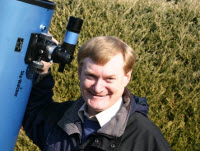 After a two year break, all being well Paul will return to Whitby on May 9th to give a presentation on the Voyager probes to coincide with their 40th launch anniversary. Entitled “Triumphs of Voyager pt 1: Journey to Jupiter/Splendours of Saturn”, it promises to be every bit as informative and entertaining as Paul’s other talks. The venue will be the main hall at Whitby college – now called the Normanby campus of Caedmon College. There is ample parking and it’s still within easy walking distance from the town.
After a two year break, all being well Paul will return to Whitby on May 9th to give a presentation on the Voyager probes to coincide with their 40th launch anniversary. Entitled “Triumphs of Voyager pt 1: Journey to Jupiter/Splendours of Saturn”, it promises to be every bit as informative and entertaining as Paul’s other talks. The venue will be the main hall at Whitby college – now called the Normanby campus of Caedmon College. There is ample parking and it’s still within easy walking distance from the town.
We are planning on providing some kind of refreshments; sausage rolls, scones, tea and coffee etc. Admission is £3 (to be agreed) The doors will be open 19:00h for an intended 19:30h start. We would like to see as many members – (past and present) as possible, plus anyone who you think may be up for an evening of PM enlightenment. Assistance would also be very welcome setting out chairs – manning the doors, taking money and with the refreshments on the night.
An electronic poster will be sent shortly after the May notes. If you can print and display somewhere it would be a mighty fine gesture.
Sky Notes
In this month's Sky Notes:
- Planetary Skylights
- Meteor Activity
- Comets: 41P Tuttle-Giacobini-Kresák and Comet 2015 V2 (Johnson)
- May 2017 Sky Charts
Planetary Skylights

 Mars finally succumbs to the encroaching evening twilight and by the end of the month is lost in glare. The Moon lies nearby on the 27th.
Mars finally succumbs to the encroaching evening twilight and by the end of the month is lost in glare. The Moon lies nearby on the 27th.
 This leaves Jupiter as the dominant planet in the evening sky. Look for the king of the planets low to the SE as May commences and further round to the south by the month’s end. It resides a little distance above the chief star of Virgo: Spica. Jupiter is an unmistakeable object and a splendid sight in any telescope. Look for the belted disk and Galilean moons; specks of light visible in line with the equatorial plane. The configuration changes each night, even over the course of an observing session you can see a discernable change in position. The Moon lies nearby Jupiter on the 7th.
This leaves Jupiter as the dominant planet in the evening sky. Look for the king of the planets low to the SE as May commences and further round to the south by the month’s end. It resides a little distance above the chief star of Virgo: Spica. Jupiter is an unmistakeable object and a splendid sight in any telescope. Look for the belted disk and Galilean moons; specks of light visible in line with the equatorial plane. The configuration changes each night, even over the course of an observing session you can see a discernable change in position. The Moon lies nearby Jupiter on the 7th.
|
07-May-2017, 22:00h:
The Moon and Jupiter Click for full-sized image |
14-May-2017, 00:30h:
The Moon and Saturn Click for full-sized image |
22-May-2017, 04:00h:
Venus and The Moon Click for full-sized image |
 Saturn rises shortly after midnight at the start of May, but is visible low in the SE by 23:00h by the end of the month. By the 19th Saturn moves from Sagittarius into Ophiuchus. A view of Saturn’s glorious ring system is not soon forgotten, and a modest telescope will reveal them easily, especially as they are favourably orientated to earth right now. The only down side is the altitude of Saturn in the sky, which for the next few years is low to the south, which means air stability and clarity will not be at its best. Patience is therefore required to catch those moments of ‘good seeing’.
Saturn rises shortly after midnight at the start of May, but is visible low in the SE by 23:00h by the end of the month. By the 19th Saturn moves from Sagittarius into Ophiuchus. A view of Saturn’s glorious ring system is not soon forgotten, and a modest telescope will reveal them easily, especially as they are favourably orientated to earth right now. The only down side is the altitude of Saturn in the sky, which for the next few years is low to the south, which means air stability and clarity will not be at its best. Patience is therefore required to catch those moments of ‘good seeing’.
Careful observation should reveal a speck of light close by Saturn, this is Titan, Saturn’s major moon. It is worth noting that the NASA probe - Cassini, which has been at Saturn since 2004, is about to undertake a series of orbits between the rings and the planet itself, so keep an eye on the media for some spectacular images. On the 13/14th The Moon rises just ahead of Saturn down in the SE.
 Finally Venus is visible low in the dawn sky across in the east. View on the 22nd when a crescent moon lies off to the right of Venus, which will also exhibit a half phase, a pleasing view to greet the new day.
Finally Venus is visible low in the dawn sky across in the east. View on the 22nd when a crescent moon lies off to the right of Venus, which will also exhibit a half phase, a pleasing view to greet the new day.
Meteor Showers

If you are an early riser look out for some shooting stars around May 5/6th when the Eta Aquariid meteor shower reaches a peak. This is one of two meteor showers associated with debris particles deposited over time by comet Halley, the other shower being the Orionids seen in late October.
Eta Aquarids have a ZHR (zenith hourly rate) approaching 30, but with Aquarius only just rising in the SE shortly before dawn, observations from the UK are restricted. The radiant of the shower lies close to Eta Aquarius, one of the stars making up the "water jar" in the otherwise faint constellation of Aquarius. The Moon will have set by early dawn, so observing around 04:00h (before twilight becomes too bright) should yield some meteors.
Comet 41P Tuttle-Giacobini-Kresák
Orbiting the Sun every 5.4 years, this was the closest approach by comet TGK in our lifetime and as such should have been readily visible through binoculars during early April reaching magnitude + 6.5.
Some members did in fact look for the comet after the April meeting, however moonlight hampered observations and a positive sighting could not be confirmed.
For the next two weeks strong moonlight interfered, however in the wee small hours of April 26th (02:00h) Mark did finally track down 41P. An interesting fact was that the comet was not located where Stellarium or many of the internet charts had it placed for that set date - as mark had suspected.
Starry night pro plus (the planetarium program the society use) had been accurate. The comet appeared as a small, subtle fuzz ball. No tail was apparent visually. Comet 41P is now heading downwards along the left-hand side of the Keystone in Hercules, before passing to the right of Vega in Lyra.
Comet 2015 V2 (Johnson)
Discovered in November of 2015, comet V2 should be well placed for northern hemisphere observers at a decent altitude throughout the spring and early summer months. The comet reaches perihelion on June 11 when it will be 1.63 AU from the Sun and 0.8 AU behind the Earth.
The comet should become a fairly easy binocular object by May until early July peaking at mag+6 in late June. From January until mid-June C/2015 V2 (Johnson) will either be in Boötes or north-western Hercules. As it plunges south during June, it passes just five degrees east of the brilliant star Arcturus on the third of the month.
May 2017 Sky Charts
Click each image to see a full-size Sky Chart:
|
Looking North
Mid-May - 22:00h |
Looking South |
|
Looking East
Mid-May - 22:00h |
Looking West
Mid-May - 22:00h |
| Northern Aspect Mid-May - 23:00h |
Southern Aspect Mid-May - 23:00h |
Additional Image Credits:
- Planets and Comets where not otherwise mentioned: NASA
- Sky Charts: Stellarium Software
Events
 Observe the night sky with us at the Bruce Observatory, Whitby School
Observe the night sky with us at the Bruce Observatory, Whitby School
Observing Nights are held weather permitting: check for a relatively clear sky before leaving home. If in doubt, Mark can be reached on 07886069339
Please note the college drive gate is now operated via a electronic key code - so anyone wishing to attend must be at the car park at the top of the drive by 19:00hrs - unless an arrival time has been arranged with Mark/Keith.
 Observe the night sky with us at the Bruce Observatory, Whitby School
Observe the night sky with us at the Bruce Observatory, Whitby School
Observing Nights are held weather permitting: check for a relatively clear sky before leaving home. If in doubt, Mark can be reached on 07886069339
Please note the college drive gate is now operated via a electronic key code - so anyone wishing to attend must be at the car park at the top of the drive by 19:00hrs - unless an arrival time has been arranged with Mark/Keith.
 Whitby School - Room H1.
Whitby School - Room H1.
In Members' monthly meetings we usually take a tour of the night sky for the coming month using the Planetarium program. Have talks and presentations on various topics of astronomy/space etc, and discuss future events etc. New members welcome.


